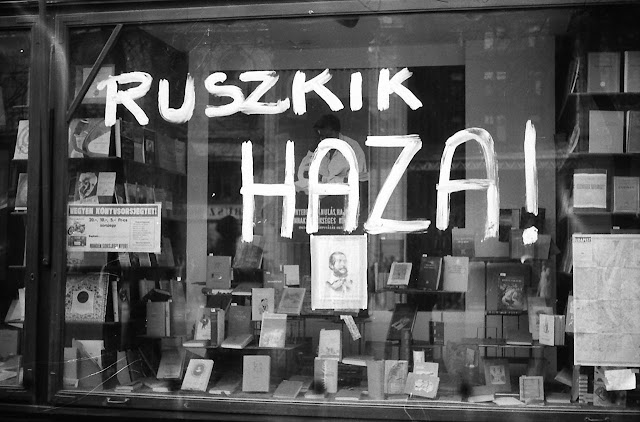Continuing a brief look at the events and persons listed in Billy Joel’s “We Didn’t Start the Fire”.
Each two lines represent a year.
Joseph Stalin, Malenkov, Nasser and Prokofiev
Rockefeller, Campanella, Communist Bloc
Roy Cohn, Juan Peron, Toscanini, dacron
Dien Bien Phu falls, "Rock Around the Clock"
Einstein, James Dean, Brooklyn's got a winning team
Davy Crockett, Peter Pan, Elvis Presley, Disneyland
Bardot, Budapest, Alabama, Krushchev
Princess Grace, "Peyton Place", trouble in the Suez
1956
Bardot, Budapest, Alabama, Krushchev
Princess Grace, "Peyton Place", trouble in the Suez
Today:
Budapest:
On 23 October 1956, a demonstration by students of the Budapest University of Technology and Economics escalated into an uprising against the government in Budapest. Popular uprisings in Hungary against Soviet occupation and repression resulted in what has been termed the Hungarian Revolution and the Hungarian Uprising.
On 1 November, Soviet tanks began rolling into Hungary and from 4 to 10 November forces began suppressing the uprising with air strikes, artillery bombardments, and tank-infantry actions. The Hungarian resistance continued until 10 November. Over 2,500 Hungarians and 700 Soviet troops were killed in the conflict, and 200,000 Hungarians fled as refugees. In Austria, large refugee camps were constructed from which emigration to other countries was arranged for the many refugees who escaped across the border prior to the military closure. Mass arrests and denunciations continued for months thereafter.
Relevance to 1956:
See above
Gallery:
March of protesters on 25 October
Hungarian revolutionaries, beginning of November 1956
Crowd cheers Hungarian troops in Budapest
Soviet T-54 tanks in Budapest on 31 October
Ruszkik haza! (Russians go home!) slogan in Budapest
Rubble after end of fighting in Budapest 8th District
By the way:
The Games of the XVI Olympiad were hosted by Melbourne, Australia between 22 November and 8 December, 1956.
There had already been tensions in respect of the Olympics between Hungary and Russia in that the Russians, who already occupied Hungary prior to the uprising, had been spying on the Hungarian water polo team, the reigning Olympic champions. They used their political control of Hungary to study and copy the Hungarian training methods and tactics.
At the time of the uprising, the Hungarian water polo team was in a mountain training camp above Budapest. With the Summer Olympics in Melbourne a month away, they were moved into Czechoslovakia and only learned of the true extent of the uprising and the subsequent crackdown after arriving in Australia. They were all anxious for news of friends and family.
By the start of the Olympics, the uprising had been suppressed and many players saw the Olympics as a way to salvage pride for their country. The water polo match was played in front of a partisan crowd bolstered with expatriate Hungarians (many of whom had been in the boxing arena before to see the Hungarian László Papp) as well as Australians and Americans, two of the Soviet Union's Cold War opponents.
Hungary and the Soviet Union met in a semi-final on 6 December 1956 in what has come to be known as the Blood in the Water Match. The Hungarians had created a strategy to taunt and thereby distract the Russians, whose language they had studied in school. From the beginning, kicks and punches were exchanged.
With one minute remaining in the match, Hungary was leading 4–0. Zádor, who had scored two goals for Hungary, was marking Valentin Prokopov, with whom he had already exchanged words, and a whistle was blown. In the intermission, Prokopov struck him, causing a bleeding gash. Zádor left the pool; his bleeding was the final straw for a crowd already in frenzy. Many angry spectators jumped onto the concourse beside the water, shook their fists, shouted abuse and spat at the Russians. To avoid a riot, police entered the arena and shepherded the crowd away.
Pictures of Zádor's injuries were published around the world, leading to the "Blood in the Water" title,
The referees stopped the match; Hungary was declared the winner since they had been leading. Hungary then beat Yugoslavia 2–1 in the final to win their fourth Olympic gold medal. Zádor's injury forced him to miss the match. After the event was completed, he and some of his teammates defected to the West.
Gallery:
Ervin Zador leaves the pool after having been hit by Russian Valentin Prokopov, Blood in the Water Match, Hungary V. USSR, (1956), Melbourne Olympics.
Ervin Zador, right, gets attention from teammate Miklos Martin for the injury sustained against Russia at Melbourne Olympic Games in 1956.
Same pic as above, in colour
An injured Ervin Zador after competing against Russia in the 1956 Olympic Games in Melbourne.
The Olympic water polo venue for the 1956 Melbourne Olympics,













No comments:
Post a Comment
Note: Only a member of this blog may post a comment.